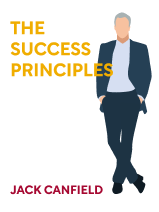

This article is an excerpt from the Shortform book guide to "The Success Principles" by Jack Canfield. Shortform has the world's best summaries and analyses of books you should be reading.
Like this article? Sign up for a free trial here .
Do you feel like you lack purpose and direction in your life? How do people even discover their purpose?
Finding your purpose in life is not just a cheesy cliche tossed around by spiritual gurus. If you haven’t decided on your purpose, your life won’t be as nearly as fulfilling as it could have been if it was informed by a sense of direction that’s in turn informed by your dream.
Read more about finding your purpose in life and how to take your first steps to achieve it.
Find Your Purpose
If you don’t feel a sense of purpose, it’s easy to go aimlessly through life without feeling as though you’re achieving anything worthwhile or meaningful. But when you know your life’s purpose and direction, you can tailor your actions to support that purpose. When your actions align with your purpose, you feel satisfied.
There are several strategies for finding your purpose in life:
1. List the times you have felt most happy. Evaluate whether they share any similar characteristics, and brainstorm ways you could earn your living from them.
2. Meditate. Quiet your mind and ask yourself what your purpose or role in the world is. (How to meditate is discussed further in Principle 47.)
3. Make a Life Purpose Statement. Here are the steps:
- Write two characteristics you like about yourself, such as “creative” or “deep-thinker.”
- Write two verbs that capture how you enjoy expressing those qualities, such as “facilitate” and “collaborate.”
- In the present tense, describe your ideal world and what everyone would be doing. For example, “Everyone is being kind to their neighbor.”
- Use your answers to the above questions to write a short statement describing your life’s purpose. For example: “My purpose is to use my creativity and planning skills to facilitate the development of equitably designed neighborhoods.” Once you’ve made your statement, read it every day, or write it down and place it where you’ll see it. You can also create art that represents your goal and put it where you’ll see it every day. This will remind you to align your actions with that statement in order to achieve your goals.
4. Complete a “Passion Test,” a 10-question exercise described in the book The Passion Test by Chris and Janet Attwood.
5. Complete Canfield’s “Life Purpose Guided Visualization” from his Awakening Power meditation series.
Explore What You Want
When we were babies, we knew what we wanted and acted swiftly, without shame, to get it. For example, if you were hungry, you would cry and be fed. But as you got older, your wants became more complex, and you likely got more negative responses, such as:
- Things cost money.
- Just because you want something doesn’t mean you can have it.
- I need you to do (BLANK) instead of what you want to do.
- Stop being selfish.
Over time, giving up on what you want can lead you to consistently put the needs of others above your own rather than identifying and working toward what you want and need. For example, you might want to be a teacher, but you become a lawyer because it’s what your parents want.
Exercises to Identify What You Want
Try the following exercises to rediscover your wants:
1. Be mindful of your preferences in every situation. When someone asks you what you’d prefer, you might choose to avoid confrontation by saying that you don’t know or don’t have a preference when you actually do have a preference. For example, maybe you’d prefer to eat out at a different restaurant than your friends prefer, but you don’t want to upset them by speaking out. To build mindfulness of your preferences, learn to recognize when you have wants and needs, even if the situation feels inconsequential. Learning to stand up for what you want on the little things will build your confidence to work toward bigger achievements.
2. Write 30 things that you want to be, 30 things you want to have, and 30 things you want to do before you die. For example, maybe you want to become an admired chef or win a Scrabble tournament. In later chapters, you’ll learn how to get there.
3. Have a friend ask you “What do you want?” repeatedly for 10 minutes and write down your answers. Some of your first answers may be basic things, like a trip to San Diego. As you go on, your answers may become more complex, like, “I want to improve my relationship with my sister.”
4. Write 20 things you love to do. People often think they can’t do what they love to earn a living. But with some creativity, there are ways to align your passions with your work. List your passions and consider ways to earn money from them. For example, if you love sports and want to make your living from it, there are many careers where you can do so, from playing a sport to journalism.
5. Create a vision for your ideal life, focusing on seven key areas:
- Relationships. Think about your relationships with your family and friends and what they would ideally look like. For example, think about what characteristics you want in a romantic partner, who you want your friends to be, and what the defining qualities of those relationships will be.
- Leisure. Think about how you’d spend your free time. For example, ask yourself where you’d vacation, and what you’d do in your spare time.
- Health. Decide what it means to be healthy. For this category, think about what you’d eat, what exercise you’d do, and how long you’d live.
- Finances. Think about what financial health means to you. Consider things like what kinds of investments you’d have, what kinds of possessions you’d own, and what these possessions would look like. For example, think about the house you’d like to own and visualize each detail in each room.
- Community. Think about where you’d live and how you and others would participate in the community, whether through philanthropic work or supporting one another.
- Career. Consider what you’d do for work, what your coworkers would be like, and if you’d own your business.
- Personal growth. Envision a plan to grow throughout your life. Consider activities like continuing your education, taking on new hobbies, or developing your spirituality. Review your vision everyday and share it with others to keep it fresh in your mind and inspire you to work toward it. Other benefits of sharing your vision include:
- Receiving resources or contacts to help achieve it. The people you share your vision with may have advice or be able to direct you to someone who can help you.
- An increasingly sharper vision. As you share your vision with people you may refine it to reflect exactly what you want.
- Feeling like it’s achievable. Sharing with more people will help you feel more comfortable with the vision, which in turn will make you feel capable of achieving it.
Teaching Others Martial Arts: Logan Doughty’s Story
Logan Doughty needed help recovering from drug and alcohol addiction. He checked into a program that helped him gradually reclaim his life. While he was in the program, his sister gave him The Success Principles. When Doughty read the section on identifying what he wanted to do, he realized he’d always thought about earning a living from a money standpoint, rather than making a living from activities he enjoyed.
When he wrote down 20 things he loved, he realized that the answer to aligning his passion with earning a living was in front of him all along: Teaching martial arts. He’d started developing a program to teach women self-defense, but his alcohol and drug addiction had slowly eclipsed his life, and he lost the self-respect and discipline needed to practice martial arts. When he left the rehab program, he started earning money through a yard work business while also becoming the martial arts instructor at the program.

———End of Preview———
Like what you just read? Read the rest of the world's best book summary and analysis of Jack Canfield's "The Success Principles" at Shortform .
Here's what you'll find in our full The Success Principles summary :
- The 67 principles to help anyone achieve their goals and dreams
- Why achieving your goals requires you to invest your time and effort
- How to take responsibility for your own life






